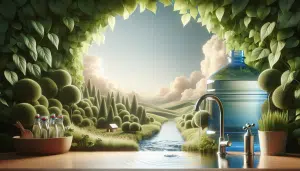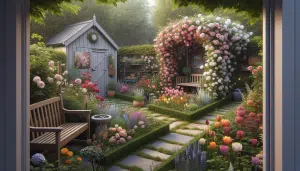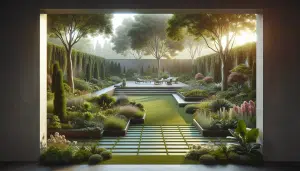Smart Ways You Can Transform Any Small Garden
Lily Carter October 28, 2025
Explore creative and practical methods to turn even the smallest garden spaces into green oases. Discover smart tips for maximizing vertical gardening, container planting, seasonal care, and sustainable approaches that help you make the most of every inch in your garden.
Unlocking Vertical Gardening for Small Spaces
Vertical gardening offers a powerful solution for optimizing limited outdoor space in any small garden. Instead of spreading plants horizontally, this approach utilizes walls, fences, and trellises to grow upward, freeing up valuable ground. The strategy favors residents looking for home improvement ideas that offer both style and substance, especially when traditional lawns or wide beds are out of reach. Hanging planters filled with edible herbs, climbing vegetables, or flowering vines not only maximize square footage but also improve garden aesthetics. By leveraging vertical surfaces, it is possible to add lushness and variety without crowding walkways or living areas, an approach widely recommended by modern horticulturists (https://extension.colostate.edu/topic-areas/yard-garden/vertical-gardening-7-238/).
Beyond practicality, vertical gardening encourages creativity in design. Homeowners can experiment with repurposed items such as pallets, hanging baskets, or even rain gutters to grow plants in unexpected ways. This method allows gardeners to curate living walls of succulents, ferns, or leafy greens that bring interest to previously ignored corners. Not only does it introduce diversity in plant choices, but the elevation helps reduce common gardening issues like pests and ground-based diseases. Carefully selected plants thrive when their sunlight, water, and airflow needs are balanced with vertical supports. Using modular vertical systems or simple trellis solutions can make set-up swift and maintenance straightforward.
Vertical gardens can also be surprisingly sustainable. Incorporating drip irrigation or self-watering planters makes water use more efficient, an important consideration for eco-conscious gardeners. Many find that vertical planting helps conserve soil moisture and enhances microclimates around walls, leading to healthier, more resilient foliage. Overall, this technique stands out as an excellent strategy for transforming patios, balconies, or compact yards into vibrant green retreats. Besides, window boxes and vertical shelves easily fit into indoor home décor, lending greenery not just outside, but inside as well.
Container Gardening: Flexibility and Abundance
Container gardening embodies flexibility for anyone eager to embark on small garden projects. Pots, barrels, and planter boxes come in endless shapes and sizes, allowing for effortless rearrangement and seasonal refreshes. Whether aiming for lush annual flowers or a thriving vegetable patch, containers can adapt to changing sunlight and space limitations. This chapter in the small garden journey is ideal for renters or anyone wanting a temporary gardening setup that packs visual punch without permanent groundwork (https://edis.ifas.ufl.edu/publication/EP372).
Container-grown plants have unique requirements, but they also bring distinct advantages. Quality potting mix, efficient drainage, and mindful watering are crucial for success, especially in containers where soil can dry rapidly. With careful planning, it’s easy to build eye-catching color stories or culinary gardens using containers. Mixing heights, textures, and bloom times creates interest throughout the growing season. Containers can be clustered for dramatic effect or lined along pathways for clear definition and movement within the garden.
Additionally, container gardening can boost accessibility for those with mobility challenges or busy lifestyles. Raised planters minimize bending and allow gardening on balconies, patios, and rooftops. It also helps control invasive species, prevents the spread of soil-borne diseases, and supports targeted fertilizing for each individual plant. These advantages lend themselves well to those seeking low-maintenance garden ideas that still foster creativity, sustainability, and abundance in small, urban, or unconventional spaces.
Choosing the Right Plants for Compact Gardens
Plant selection is key to thriving in small spaces. For compact gardens, prioritizing dwarf cultivars or varieties bred specifically for small containers pays off in the long run. Many reputable nurseries and seed suppliers offer miniature tomatoes, peppers, squash, and a wide array of flowers that excel in pots and raised beds. Succession planting—refreshing the garden with new seedlings as crops are harvested—is also ideal for getting the most from limited soil (https://hgic.clemson.edu/factsheet/vegetable-gardening-in-containers/).
Pairing fast-growing greens like lettuce or arugula with trailing herbs or edible flowers ensures year-round beauty and yield. Using companion planting techniques can reduce pests while enhancing growth and flavor. Pair marigolds, basil, or nasturtiums with vegetables to attract pollinators and repel unwanted insects. Shade-tolerant species such as spinach, mint, and ferns fill in shaded corners, maximizing even those less sunny spots within the garden, creating a lush, layered effect.
For ornamental appeal, mixing annuals and perennials diversifies color, texture, and seasonality. Dwarf bulbs, compact roses, and trailing lobelia offer blooms from spring to fall. Thoughtful plant combinations mean there’s always something beautiful on show. Adopting a diverse planting palette brings both pollinator activity and aesthetic delight, ensuring that even small gardens pulse with life. This careful curation balances beauty, utility, and seasonal interest, making small spaces feel grand.
Seasonal Maintenance Strategies for Lasting Beauty
Year-round garden success relies on well-timed seasonal maintenance. Start with soil: re-enrich pots with compost or organic matter at the start of each season to replenish spent nutrients. Regularly turning the soil, removing debris, mulching, and top-dressing helps support robust plant health. These small acts can have a big impact, especially when combined with monitoring for pests, disease, or changes in sunlight exposure. Routine attention keeps growth steady and minimizes setbacks (https://web.extension.illinois.edu/containergardening/maintenance.cfm).
Irrigation demands change with the seasons. Warmer months may require more frequent watering to prevent wilting, while cool, wet stretches can mean letting soil dry out between waterings. Adjusting your garden schedule helps avoid overwatering or underwatering. Fertilizing every few weeks with a diluted, organic solution supports continuous blooms or fruitful harvests, especially in containers where nutrients wash away quickly. Periodic pruning keeps plants compact, encourages branching, and prevents overgrowth. Simple checks and adjustments cultivate resilience in small gardens year-round.
In colder climates, protection from frost becomes essential. Moving pots to sheltered locations, wrapping containers with insulating materials, or choosing cold-hardy varieties safeguards vulnerable growth. Strategic planning, such as swapping summer annuals for autumn pansies or hardy kale, ensures that your small garden remains lively, even through seasonal transitions. This proactive and flexible approach provides a template that adapts to any environment, making a small outdoor space an ever-evolving sanctuary.
Sustainable Solutions to Make the Most of Small Spaces
Eco-friendly approaches are especially valuable in compact home gardens. Mulching, composting, and reusing rainwater are practical ways to reduce waste and lower costs. Even simple steps, such as installing a rain barrel or compost bin, help recycle garden refuse into valuable fertilizer or water, feeding back into the garden ecosystem. These strategies allow gardeners to embrace sustainability at any scale, supporting native wildlife while making a positive impact on the environment (https://www.epa.gov/recycle/composting-home).
Growers can further boost sustainability by selecting native or drought-resistant plants. These species require less water, fertilizer, and intervention, preserving resources and simplifying care. Exploring natural pest control, like beneficial insects or homemade remedies, helps maintain plant health without relying on chemical solutions. Many gardeners are now experimenting with permaculture principles—even within small lots—to foster biodiversity and create self-sustaining, resilient plots with minimal intervention.
Incorporating sustainability also includes thoughtful material choices for containers, trellises, and decorations. Opt for biodegradable, upcycled, or recycled products to minimize environmental impact. Beyond personal satisfaction, these small choices contribute to a greener future for the entire neighborhood. With creative problem-solving and a commitment to stewardship, small-space gardeners turn constraints into opportunities, weaving responsibility and delight together in every square foot.
Creative Design Ideas to Expand Your Green Space
Expanding a small garden’s potential often relies on clever design illusions. Mirrors, reflective surfaces, and light-colored finishes visually enlarge tight corners, making spaces feel more open. Curved pathways, staggered plant heights, and layered flower beds introduce depth and interest, prompting the eye to wander and explore. Thoughtfully selected garden art or water features can draw attention to focal points, adding the illusion of more space and character to a pocket-sized garden (https://extension.unh.edu/resource/designing-small-garden-fact-sheet).
Flexible furniture—like fold-away benches or stackable chairs—creates usable zones without crowding. Portable lighting, small fountains, and multifunctional tables further increase usability. Hanging baskets, window boxes, and wall-mounted planters raise the garden upwards and distribute greenery at eye level. This enables you to combine lushness and functionality in even the tightest layouts. Each design choice amplifies the garden’s charm while maintaining easy access and flow.
Color theory also plays a significant role in shaping perception. Cool hues like blues, greens, and purples create a sense of calm and visual distance, whereas warm colors energize and draw features closer. Using repetition and symmetry brings cohesion to eclectic spaces. With resourcefulness, even a compact patio or balcony can become an inviting, relaxing retreat, proving that size need not limit imagination or joy.
References
1. Colorado State University Extension. (n.d.). Vertical Gardening. Retrieved from https://extension.colostate.edu/topic-areas/yard-garden/vertical-gardening-7-238/
2. University of Florida IFAS Extension. (n.d.). Gardening in Containers. Retrieved from https://edis.ifas.ufl.edu/publication/EP372
3. Clemson Cooperative Extension. (n.d.). Vegetable Gardening in Containers. Retrieved from https://hgic.clemson.edu/factsheet/vegetable-gardening-in-containers/
4. University of Illinois Extension. (n.d.). Container Gardening: Maintenance. Retrieved from https://web.extension.illinois.edu/containergardening/maintenance.cfm
5. U.S. Environmental Protection Agency. (n.d.). Composting at Home. Retrieved from https://www.epa.gov/recycle/composting-home
6. University of New Hampshire Extension. (n.d.). Designing a Small Garden. Retrieved from https://extension.unh.edu/resource/designing-small-garden-fact-sheet







